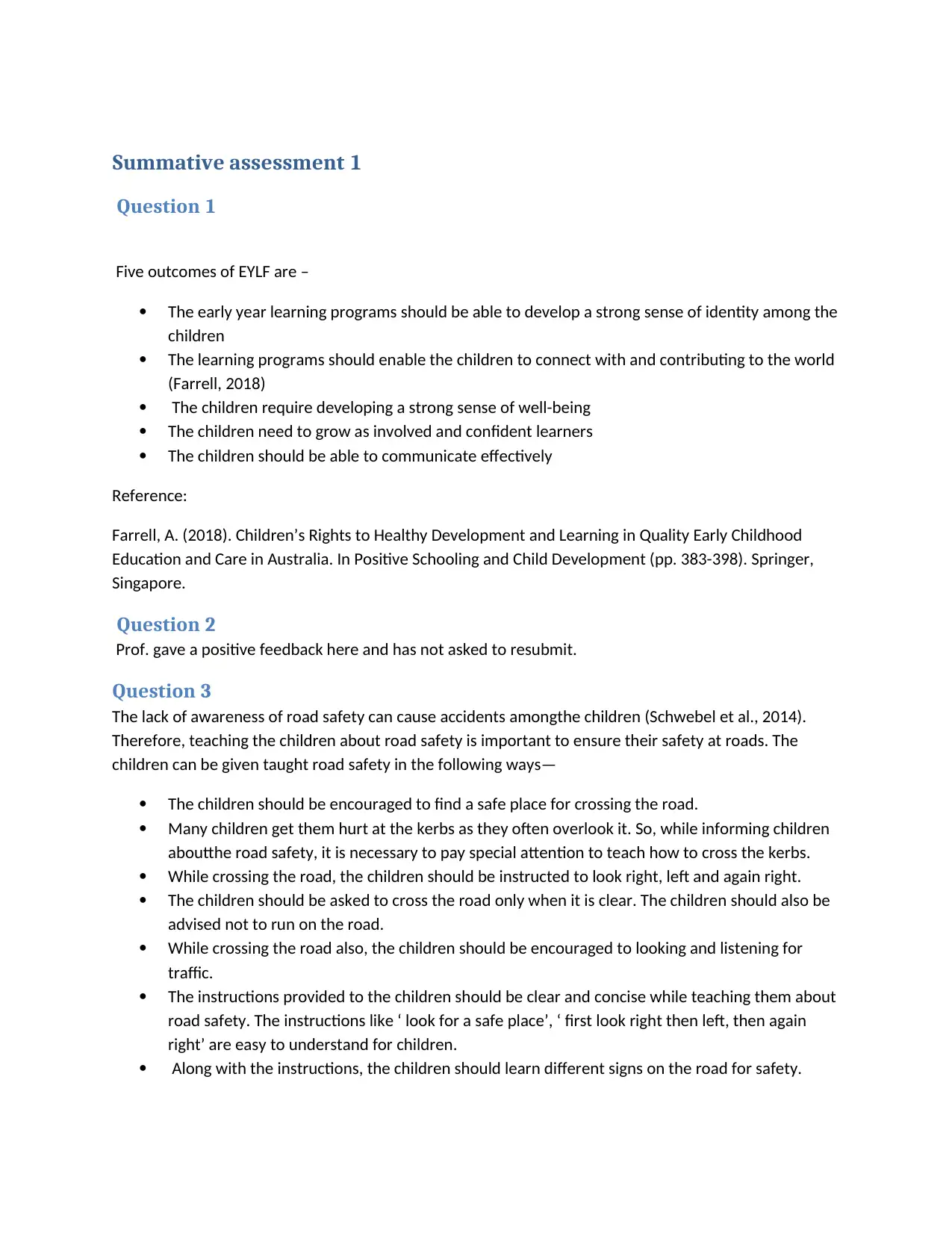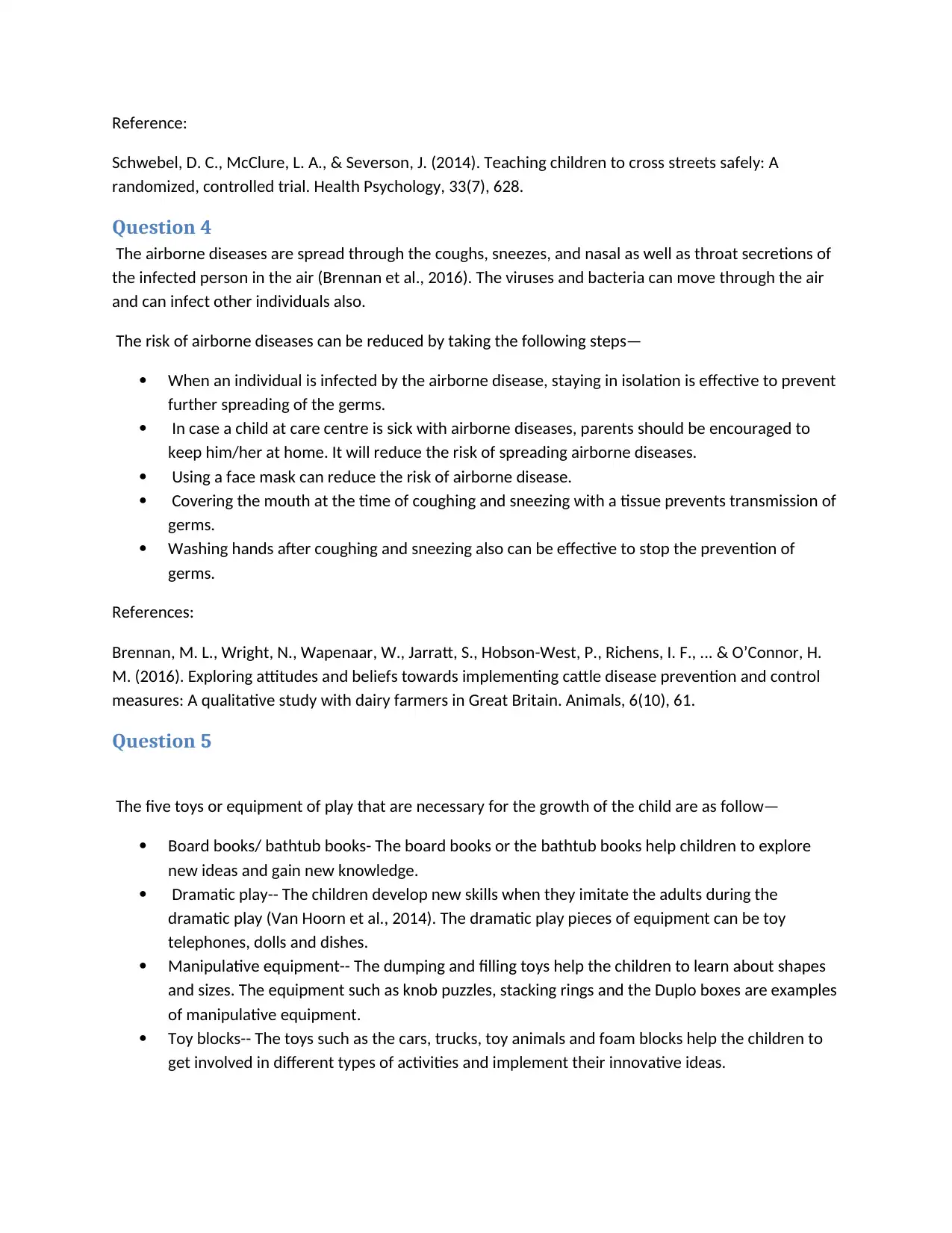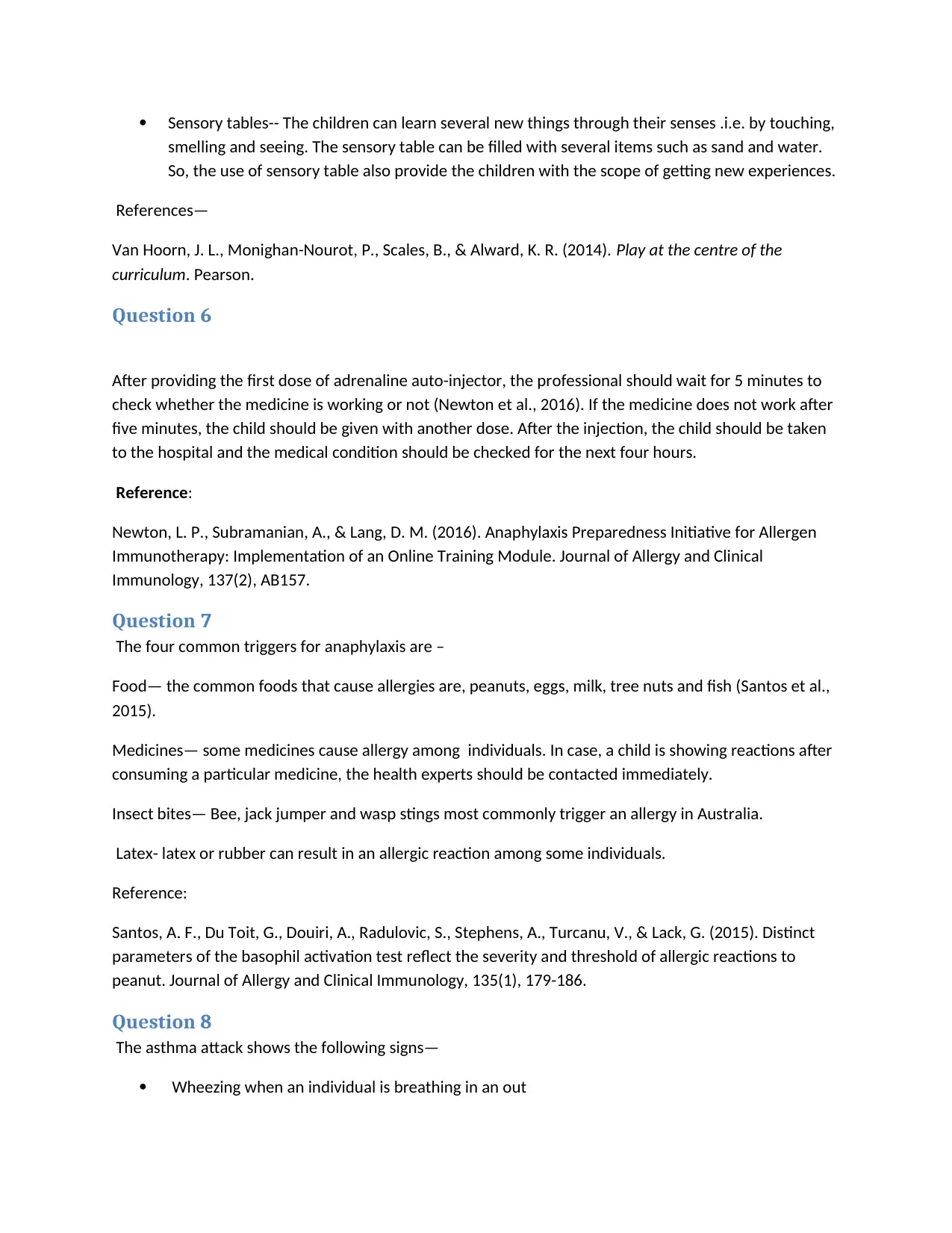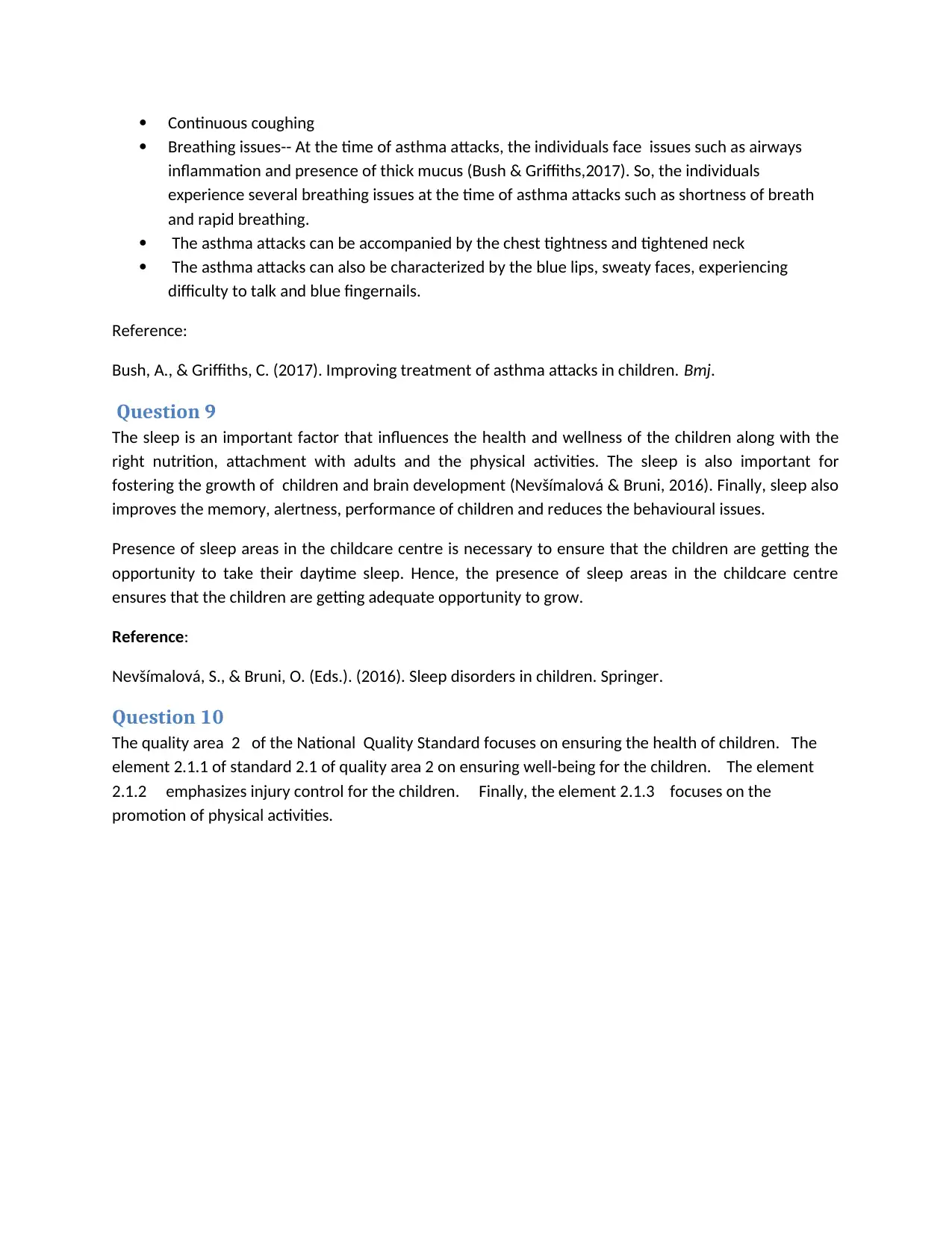Summative Assessment 1: Early Childhood Learning
VerifiedAdded on 2019/10/09
|4
|1526
|319
Homework Assignment
AI Summary
This document presents the solutions to a summative assessment focused on early childhood learning. It covers various topics including the five outcomes of the Early Years Learning Framework (EYLF), road safety measures for children, prevention of airborne diseases, essential play equipment, anaphylaxis management, asthma symptoms, the importance of sleep, and the National Quality Standard's focus on children's health. Each question is addressed with detailed explanations and relevant references, providing a comprehensive understanding of the key concepts in early childhood education and care.

Summative assessment 1
Question 1
Five outcomes of EYLF are –
The early year learning programs should be able to develop a strong sense of identity among the
children
The learning programs should enable the children to connect with and contributing to the world
(Farrell, 2018)
The children require developing a strong sense of well-being
The children need to grow as involved and confident learners
The children should be able to communicate effectively
Reference:
Farrell, A. (2018). Children’s Rights to Healthy Development and Learning in Quality Early Childhood
Education and Care in Australia. In Positive Schooling and Child Development (pp. 383-398). Springer,
Singapore.
Question 2
Prof. gave a positive feedback here and has not asked to resubmit.
Question 3
The lack of awareness of road safety can cause accidents amongthe children (Schwebel et al., 2014).
Therefore, teaching the children about road safety is important to ensure their safety at roads. The
children can be given taught road safety in the following ways—
The children should be encouraged to find a safe place for crossing the road.
Many children get them hurt at the kerbs as they often overlook it. So, while informing children
aboutthe road safety, it is necessary to pay special attention to teach how to cross the kerbs.
While crossing the road, the children should be instructed to look right, left and again right.
The children should be asked to cross the road only when it is clear. The children should also be
advised not to run on the road.
While crossing the road also, the children should be encouraged to looking and listening for
traffic.
The instructions provided to the children should be clear and concise while teaching them about
road safety. The instructions like ‘ look for a safe place’, ‘ first look right then left, then again
right’ are easy to understand for children.
Along with the instructions, the children should learn different signs on the road for safety.
Question 1
Five outcomes of EYLF are –
The early year learning programs should be able to develop a strong sense of identity among the
children
The learning programs should enable the children to connect with and contributing to the world
(Farrell, 2018)
The children require developing a strong sense of well-being
The children need to grow as involved and confident learners
The children should be able to communicate effectively
Reference:
Farrell, A. (2018). Children’s Rights to Healthy Development and Learning in Quality Early Childhood
Education and Care in Australia. In Positive Schooling and Child Development (pp. 383-398). Springer,
Singapore.
Question 2
Prof. gave a positive feedback here and has not asked to resubmit.
Question 3
The lack of awareness of road safety can cause accidents amongthe children (Schwebel et al., 2014).
Therefore, teaching the children about road safety is important to ensure their safety at roads. The
children can be given taught road safety in the following ways—
The children should be encouraged to find a safe place for crossing the road.
Many children get them hurt at the kerbs as they often overlook it. So, while informing children
aboutthe road safety, it is necessary to pay special attention to teach how to cross the kerbs.
While crossing the road, the children should be instructed to look right, left and again right.
The children should be asked to cross the road only when it is clear. The children should also be
advised not to run on the road.
While crossing the road also, the children should be encouraged to looking and listening for
traffic.
The instructions provided to the children should be clear and concise while teaching them about
road safety. The instructions like ‘ look for a safe place’, ‘ first look right then left, then again
right’ are easy to understand for children.
Along with the instructions, the children should learn different signs on the road for safety.
Paraphrase This Document
Need a fresh take? Get an instant paraphrase of this document with our AI Paraphraser

Reference:
Schwebel, D. C., McClure, L. A., & Severson, J. (2014). Teaching children to cross streets safely: A
randomized, controlled trial. Health Psychology, 33(7), 628.
Question 4
The airborne diseases are spread through the coughs, sneezes, and nasal as well as throat secretions of
the infected person in the air (Brennan et al., 2016). The viruses and bacteria can move through the air
and can infect other individuals also.
The risk of airborne diseases can be reduced by taking the following steps—
When an individual is infected by the airborne disease, staying in isolation is effective to prevent
further spreading of the germs.
In case a child at care centre is sick with airborne diseases, parents should be encouraged to
keep him/her at home. It will reduce the risk of spreading airborne diseases.
Using a face mask can reduce the risk of airborne disease.
Covering the mouth at the time of coughing and sneezing with a tissue prevents transmission of
germs.
Washing hands after coughing and sneezing also can be effective to stop the prevention of
germs.
References:
Brennan, M. L., Wright, N., Wapenaar, W., Jarratt, S., Hobson-West, P., Richens, I. F., ... & O’Connor, H.
M. (2016). Exploring attitudes and beliefs towards implementing cattle disease prevention and control
measures: A qualitative study with dairy farmers in Great Britain. Animals, 6(10), 61.
Question 5
The five toys or equipment of play that are necessary for the growth of the child are as follow—
Board books/ bathtub books- The board books or the bathtub books help children to explore
new ideas and gain new knowledge.
Dramatic play-- The children develop new skills when they imitate the adults during the
dramatic play (Van Hoorn et al., 2014). The dramatic play pieces of equipment can be toy
telephones, dolls and dishes.
Manipulative equipment-- The dumping and filling toys help the children to learn about shapes
and sizes. The equipment such as knob puzzles, stacking rings and the Duplo boxes are examples
of manipulative equipment.
Toy blocks-- The toys such as the cars, trucks, toy animals and foam blocks help the children to
get involved in different types of activities and implement their innovative ideas.
Schwebel, D. C., McClure, L. A., & Severson, J. (2014). Teaching children to cross streets safely: A
randomized, controlled trial. Health Psychology, 33(7), 628.
Question 4
The airborne diseases are spread through the coughs, sneezes, and nasal as well as throat secretions of
the infected person in the air (Brennan et al., 2016). The viruses and bacteria can move through the air
and can infect other individuals also.
The risk of airborne diseases can be reduced by taking the following steps—
When an individual is infected by the airborne disease, staying in isolation is effective to prevent
further spreading of the germs.
In case a child at care centre is sick with airborne diseases, parents should be encouraged to
keep him/her at home. It will reduce the risk of spreading airborne diseases.
Using a face mask can reduce the risk of airborne disease.
Covering the mouth at the time of coughing and sneezing with a tissue prevents transmission of
germs.
Washing hands after coughing and sneezing also can be effective to stop the prevention of
germs.
References:
Brennan, M. L., Wright, N., Wapenaar, W., Jarratt, S., Hobson-West, P., Richens, I. F., ... & O’Connor, H.
M. (2016). Exploring attitudes and beliefs towards implementing cattle disease prevention and control
measures: A qualitative study with dairy farmers in Great Britain. Animals, 6(10), 61.
Question 5
The five toys or equipment of play that are necessary for the growth of the child are as follow—
Board books/ bathtub books- The board books or the bathtub books help children to explore
new ideas and gain new knowledge.
Dramatic play-- The children develop new skills when they imitate the adults during the
dramatic play (Van Hoorn et al., 2014). The dramatic play pieces of equipment can be toy
telephones, dolls and dishes.
Manipulative equipment-- The dumping and filling toys help the children to learn about shapes
and sizes. The equipment such as knob puzzles, stacking rings and the Duplo boxes are examples
of manipulative equipment.
Toy blocks-- The toys such as the cars, trucks, toy animals and foam blocks help the children to
get involved in different types of activities and implement their innovative ideas.

Sensory tables-- The children can learn several new things through their senses .i.e. by touching,
smelling and seeing. The sensory table can be filled with several items such as sand and water.
So, the use of sensory table also provide the children with the scope of getting new experiences.
References—
Van Hoorn, J. L., Monighan-Nourot, P., Scales, B., & Alward, K. R. (2014). Play at the centre of the
curriculum. Pearson.
Question 6
After providing the first dose of adrenaline auto-injector, the professional should wait for 5 minutes to
check whether the medicine is working or not (Newton et al., 2016). If the medicine does not work after
five minutes, the child should be given with another dose. After the injection, the child should be taken
to the hospital and the medical condition should be checked for the next four hours.
Reference:
Newton, L. P., Subramanian, A., & Lang, D. M. (2016). Anaphylaxis Preparedness Initiative for Allergen
Immunotherapy: Implementation of an Online Training Module. Journal of Allergy and Clinical
Immunology, 137(2), AB157.
Question 7
The four common triggers for anaphylaxis are –
Food— the common foods that cause allergies are, peanuts, eggs, milk, tree nuts and fish (Santos et al.,
2015).
Medicines— some medicines cause allergy among individuals. In case, a child is showing reactions after
consuming a particular medicine, the health experts should be contacted immediately.
Insect bites— Bee, jack jumper and wasp stings most commonly trigger an allergy in Australia.
Latex- latex or rubber can result in an allergic reaction among some individuals.
Reference:
Santos, A. F., Du Toit, G., Douiri, A., Radulovic, S., Stephens, A., Turcanu, V., & Lack, G. (2015). Distinct
parameters of the basophil activation test reflect the severity and threshold of allergic reactions to
peanut. Journal of Allergy and Clinical Immunology, 135(1), 179-186.
Question 8
The asthma attack shows the following signs—
Wheezing when an individual is breathing in an out
smelling and seeing. The sensory table can be filled with several items such as sand and water.
So, the use of sensory table also provide the children with the scope of getting new experiences.
References—
Van Hoorn, J. L., Monighan-Nourot, P., Scales, B., & Alward, K. R. (2014). Play at the centre of the
curriculum. Pearson.
Question 6
After providing the first dose of adrenaline auto-injector, the professional should wait for 5 minutes to
check whether the medicine is working or not (Newton et al., 2016). If the medicine does not work after
five minutes, the child should be given with another dose. After the injection, the child should be taken
to the hospital and the medical condition should be checked for the next four hours.
Reference:
Newton, L. P., Subramanian, A., & Lang, D. M. (2016). Anaphylaxis Preparedness Initiative for Allergen
Immunotherapy: Implementation of an Online Training Module. Journal of Allergy and Clinical
Immunology, 137(2), AB157.
Question 7
The four common triggers for anaphylaxis are –
Food— the common foods that cause allergies are, peanuts, eggs, milk, tree nuts and fish (Santos et al.,
2015).
Medicines— some medicines cause allergy among individuals. In case, a child is showing reactions after
consuming a particular medicine, the health experts should be contacted immediately.
Insect bites— Bee, jack jumper and wasp stings most commonly trigger an allergy in Australia.
Latex- latex or rubber can result in an allergic reaction among some individuals.
Reference:
Santos, A. F., Du Toit, G., Douiri, A., Radulovic, S., Stephens, A., Turcanu, V., & Lack, G. (2015). Distinct
parameters of the basophil activation test reflect the severity and threshold of allergic reactions to
peanut. Journal of Allergy and Clinical Immunology, 135(1), 179-186.
Question 8
The asthma attack shows the following signs—
Wheezing when an individual is breathing in an out
⊘ This is a preview!⊘
Do you want full access?
Subscribe today to unlock all pages.

Trusted by 1+ million students worldwide

Continuous coughing
Breathing issues-- At the time of asthma attacks, the individuals face issues such as airways
inflammation and presence of thick mucus (Bush & Griffiths,2017). So, the individuals
experience several breathing issues at the time of asthma attacks such as shortness of breath
and rapid breathing.
The asthma attacks can be accompanied by the chest tightness and tightened neck
The asthma attacks can also be characterized by the blue lips, sweaty faces, experiencing
difficulty to talk and blue fingernails.
Reference:
Bush, A., & Griffiths, C. (2017). Improving treatment of asthma attacks in children. Bmj.
Question 9
The sleep is an important factor that influences the health and wellness of the children along with the
right nutrition, attachment with adults and the physical activities. The sleep is also important for
fostering the growth of children and brain development (Nevšímalová & Bruni, 2016). Finally, sleep also
improves the memory, alertness, performance of children and reduces the behavioural issues.
Presence of sleep areas in the childcare centre is necessary to ensure that the children are getting the
opportunity to take their daytime sleep. Hence, the presence of sleep areas in the childcare centre
ensures that the children are getting adequate opportunity to grow.
Reference:
Nevšímalová, S., & Bruni, O. (Eds.). (2016). Sleep disorders in children. Springer.
Question 10
The quality area 2 of the National Quality Standard focuses on ensuring the health of children. The
element 2.1.1 of standard 2.1 of quality area 2 on ensuring well-being for the children. The element
2.1.2 emphasizes injury control for the children. Finally, the element 2.1.3 focuses on the
promotion of physical activities.
Breathing issues-- At the time of asthma attacks, the individuals face issues such as airways
inflammation and presence of thick mucus (Bush & Griffiths,2017). So, the individuals
experience several breathing issues at the time of asthma attacks such as shortness of breath
and rapid breathing.
The asthma attacks can be accompanied by the chest tightness and tightened neck
The asthma attacks can also be characterized by the blue lips, sweaty faces, experiencing
difficulty to talk and blue fingernails.
Reference:
Bush, A., & Griffiths, C. (2017). Improving treatment of asthma attacks in children. Bmj.
Question 9
The sleep is an important factor that influences the health and wellness of the children along with the
right nutrition, attachment with adults and the physical activities. The sleep is also important for
fostering the growth of children and brain development (Nevšímalová & Bruni, 2016). Finally, sleep also
improves the memory, alertness, performance of children and reduces the behavioural issues.
Presence of sleep areas in the childcare centre is necessary to ensure that the children are getting the
opportunity to take their daytime sleep. Hence, the presence of sleep areas in the childcare centre
ensures that the children are getting adequate opportunity to grow.
Reference:
Nevšímalová, S., & Bruni, O. (Eds.). (2016). Sleep disorders in children. Springer.
Question 10
The quality area 2 of the National Quality Standard focuses on ensuring the health of children. The
element 2.1.1 of standard 2.1 of quality area 2 on ensuring well-being for the children. The element
2.1.2 emphasizes injury control for the children. Finally, the element 2.1.3 focuses on the
promotion of physical activities.
1 out of 4
Your All-in-One AI-Powered Toolkit for Academic Success.
+13062052269
info@desklib.com
Available 24*7 on WhatsApp / Email
![[object Object]](/_next/static/media/star-bottom.7253800d.svg)
Unlock your academic potential
Copyright © 2020–2025 A2Z Services. All Rights Reserved. Developed and managed by ZUCOL.